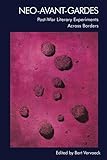Neo-Avant-Gardes : Post-War Literary Experiments Across Borders / ed. by Bart Vervaeck.
Material type: TextPublisher: Edinburgh : Edinburgh University Press, [2022]Copyright date: ©2021Description: 1 online resource (424 p.)Content type:
TextPublisher: Edinburgh : Edinburgh University Press, [2022]Copyright date: ©2021Description: 1 online resource (424 p.)Content type: - 9781474486095
- 9781474486118
- 809.91109045 23
- PN56.M54 N46 2021
- online - DeGruyter
| Item type | Current library | Call number | URL | Status | Notes | Barcode | |
|---|---|---|---|---|---|---|---|
 eBook
eBook
|
Biblioteca "Angelicum" Pont. Univ. S.Tommaso d'Aquino Nuvola online | online - DeGruyter (Browse shelf(Opens below)) | Online access | Not for loan (Accesso limitato) | Accesso per gli utenti autorizzati / Access for authorized users | (dgr)9781474486118 |
Frontmatter -- Contents -- List of Illustrations -- Acknowledgements -- Notes on Contributors -- Introduction: Neo-Avant-Garde, Why Bother? -- Part I: Concepts, Genres and Techniques -- 1. Theodor Adorno, Peter Bürger and Oswald Wiener, or How to Apply Neo-Avant-Garde Theory to Neo-Avant-Garde Texts -- 2. Despite Straight Lines: Josef Albers, Concrete Poetry and Temporal Relations -- 3. Multi-faceted Images of Reality: Montage in Documentary Literature from the Long 1960s -- 4. Foundists and Erasurists -- 5. In Praise of Hybrid Purity: Nomadism and Pierre Joris -- 6. Enigmatic and Revealing: Lucienne Stassaert’s Neo-Avant-Garde Short Story Collection Verhalen van de jonkvrouw met de spade (1964) -- 7. Sound Poetry in France: A Neo-Avant-Garde? -- 8. Surrealism Old and New in Three Generations of Prose Poets: The Case of the Low Countries -- 9. Uneven Developments: Bande Dessinée, Rear-Guard and Neo-Avant-Gardes -- 10. Differentiating the Return of the Real: Towards an Interdisciplinary Concept of the Neo-Avant-Garde -- Part II: Movements and Authors -- 11. ‘A riot is the language of the unheard’: Neo-Avant-Garde Poetic Uprisings in the Era of the Black Arts Movement -- 12. The Neo-Avant-Garde in Latin America: The Case of Mario Bellatin -- 13. Sycorax’ Revenge: Kamau Brathwaite and a Caribbean Version of the Neo-Avant-Garde -- 14. ‘Belonging nowhere?’: Labelling British Experimental Women’s Fiction of the Long Sixties -- 15. Constraint and Rule: Oulipo and the Neos -- 16. A Third Term? Avant-Garde on the Fence in France Since the 1990s -- 17. The Austrian Post-War Anomaly: Konrad Bayer’s Montage the head of vitus bering and the Category of the ‘New’ -- 18. Surrealism in Post-War Vienna -- 19. Images of the Real: Generic and Medial Hybridity in Peter Weiss’s The Shadow of the Body of the Coachman -- 20. From Zero to Neo: Ivo Michiels, Book Alpha and the Neo-Avant-Garde -- 21. Flemish Hybridity: The Magazine Labris (1962–73) and the Neo-Avant-Garde -- Index
restricted access online access with authorization star
http://purl.org/coar/access_right/c_16ec
A systematic transnational investigation of post-war literary experiments in Europe and the AmericasClarifies concepts, provides a well-defined methodology and presents a wide array of international case studiesIntroduces the reader to major experimental authors and avant-garde traditions (that are often under-discussed) highlighting the transnational and interartistic context out of which they emergedPuts new figures on the map while repositioning more established writers. In doing so, it points the way to further investigations, whose methodological foundations this book purports to establishWhat are the forms in which the avant-garde returns after the Second World War? How does the literary avant-garde re-invent itself without losing its affinity with historical avant-garde currents such as surrealism and futurism?This book explores the international relevance of the concept of neo-avant-garde for the study of post-war literary innovations covering North American, Latin American, Caribbean, Austrian, French, British, Belgian, Dutch and German cases. Each of the twenty-one newly commissioned chapters combines theoretical reflection with practical analysis. Together, they provide a multi-faceted account of diverse group and trends, such as the New Realists, Black Arts Movement, Labris and the Vienna Group. They also focus on a wide range of authors, like Pierre Alferi, Amiri Baraka, Konrad Bayer, Mario Bellatín, Kamau Brathwaite, and Anna Kavan. In addition, they pay attention to specific techniques, including erasure, lyricisation, and montage, and to specific genres such as comic books, experimental fiction, and visual poetry.
Mode of access: Internet via World Wide Web.
In English.
Description based on online resource; title from PDF title page (publisher's Web site, viewed 01. Dez 2022)


